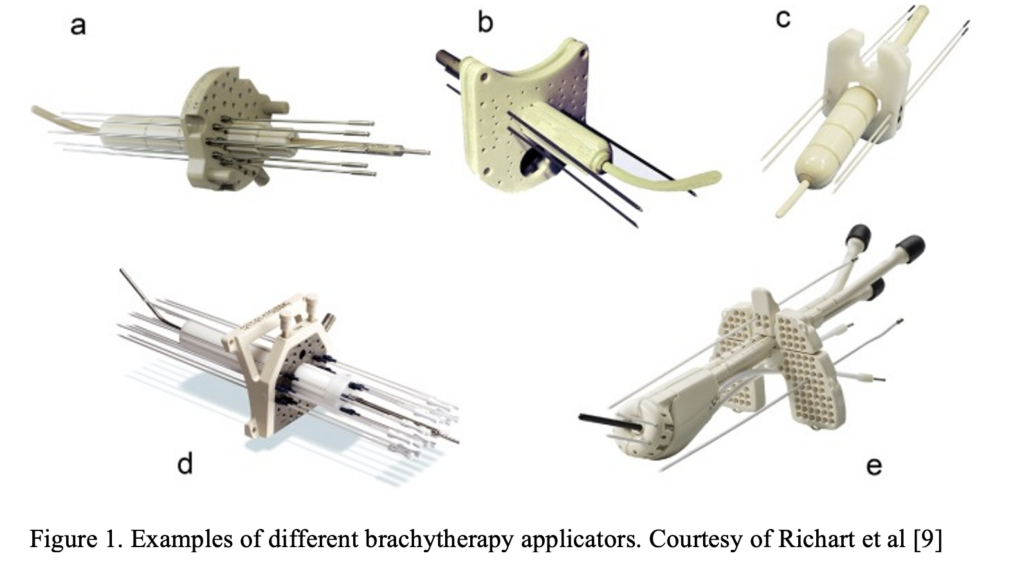External Beam Radiotherapy and Brachytherapy for the Treatment of Cervical Cancer
The September 2021 #radonc #JC features cervical cancer and will begin Saturday, September 18th at 8am CST and go through Sunday, September 19th, culminating in the Live Hour from 1-2pm CST Sunday, September 19th.
Cervical cancer is a leading cause of death due to cancer among women and is considered a global health problem, as 85% of deaths from cervical cancer across the globe happen in underdeveloped or developing countries [1-2]. While external beam radiotherapy (EBRT) – generally administered concurrently with chemotherapy – is considered a mainstay of definitive treatment for locally advanced disease, radiation may also be used for select patients with early-stage disease as an alternative to surgery [3] or in the postoperative setting [4-5].
When treating cervical cancer definitively with radiation, the treatment package incorporates brachytherapy (implanted radiation), which allows for focal dose delivery while sparing nearby organs like the bladder and rectum, thereby decreasing the likelihood of treatment-related side effects [6]. The diversity of treatment options available for cervical cancer is exemplified in part by the variety of options available for brachytherapy applicators, including intracavitary applicators (such as the tandem and ovoids [T&O] or tandem and ring [T&R]), interstitial applicators (like the Syed-Neblett template or the Martinez Universal Perineal Interstitial template), or even combinations thereof (such as the Venezia hybrid applicator) [7-9].

For the upcoming September #radonc #JC, we will be featuring the following excellent review article [10] on treatment of cervical cancer:
“Advances in External Beam Radiotherapy and Brachytherapy for Cervical Cancer”
We’re thrilled to be joined by Dr. Loren Mell (@drlorenmell) and Dr. Sushil Beriwal (@Sushilberiwal) for this month’s #radonc #JC.
Discussion will emphasize:
- Radiation delivery techniques
- Treatment planning considerations
- Advances in brachytherapy
- Ongoing areas of further exploration
Our Guiding Topics this month will be as follows:
T1. Background: Treatment of cervical cancer has changed over time. How have changes to FIGO staging, dose prescription (point A vs HR-CTV), brachytherapy delivery, and systemic therapy administration (agents and timing) affected cervical cancer treatment?
T2. Methods: When are patients with earlier stage disease treated postoperatively versus with definitive concurrent chemoradiation? What types of field design, dosing schema, and systemic therapy regimens are used in treating locally advanced cervical cancer? During which stages of treatment is MRI acquired?
T3. Results: What have been the most recent updates in cervical cancer treatment in terms of cancer-related outcomes and treatment-related effects (based on findings of randomized trials and high-quality retrospective data)?
T4. Discussion: How may we increase rates of vaccination against HPV across the globe? What are the challenges that centers face in building and sustaining active brachytherapy programs? What roles do brachytherapy, proton therapy, and stereotactic body radiotherapy hold in treating cervical cancer?
T5. #PatientsIncluded: What types of medications for symptomatic relief are provided to patients during treatment for side effects relating to the bowel, bladder, or skin? What should patients be counseled on with regards to long-term sexual side effects?
T6. Next Steps: What are ongoing trials on cervical cancer investigating? How may we further improve cervical cancer treatment?
Some tips to participate:
- Guidelines on how to sign up & participate
- Disclaimer for ways to keep #RadOnc #JC rewarding and professional. If you’re not ready, just lurk & tune in to the conversation.
References:
[1] Small W Jr, Bacon MA, Bajaj A, et al. Cervical cancer: A global health crisis. Cancer. 2017 Jul 1;123(13):2404-2412.
[2] World Health Organization. Human papillomavirus (HPV) and cervical cancer. https://www.who.int/en/news-room/fact-sheets/detail/human-papillomavirus-(hpv)-and-cervical-cancer. Accessed 10 September 2021.
[3] Landoni F, Maneo A, Colombo A, et al. Randomised study of radical surgery versus radiotherapy for stage Ib-IIa cervical cancer. Lancet. 1997 Aug 23;350(9077):535-40.
[4] Sedlis A, Bundy BN, Rotman MZ, Lentz SS, Muderspach LI, Zaino RJ. A randomized trial of pelvic radiation therapy versus no further therapy in selected patients with stage IB carcinoma of the cervix after radical hysterectomy and pelvic lymphadenectomy: A Gynecologic Oncology Group Study. Gynecol Oncol. 1999 May;73(2):177-83.
[5] Peters WA 3rd, Liu PY, Barrett RJ 2nd, Stock RJ, Monk BJ, Berek JS, Souhami L, Grigsby P, Gordon W Jr, Alberts DS. Concurrent chemotherapy and pelvic radiation therapy compared with pelvic radiation therapy alone as adjuvant therapy after radical surgery in high-risk early-stage cancer of the cervix. J Clin Oncol. 2000 Apr;18(8):1606-13.
[6] Georg D, Kirisits C, Hillbrand M, Dimopoulos J, Potter R. Image-guided radiotherapy for cervix cancer: high-tech external beam therapy versus high-tech brachytherapy. Int J Radiat Oncol Biol Phys. 2008;71:1272-1278.
[7] Banerjee R, Kamrava M. Brachytherapy in the treatment of cervical cancer: a review. Int J Womens Health. 2014 May 28;6:555-64. doi: 10.2147/IJWH.S46247.
[8] Kissel M, Fournier-Bidoz N, Henry O, et al. Venezia applicator with oblique needles improves clinical target volume coverage in distal parametrial tumor residue compared to parallel needles only. J Contemp Brachytherapy. 2021;13(1):24-31.
[9] Richart J, Carmona-Meseguer V, García-Martínez T, Herreros A, Otal A, Pellejero S, Tornero-López A, Pérez-Calatayud J. Review of strategies for MRI based reconstruction of endocavitary and interstitial applicators in brachytherapy of cervical cancer. Rep Pract Oncol Radiother. 2018 Nov-Dec;23(6):547-561.
[10] Williamson CW, Liu HC, Mayadev J, Mell LK. Advances in External Beam Radiation Therapy and Brachytherapy for Cervical Cancer. Clin Oncol (R Coll Radiol). 2021 Sep;33(9):567-578.